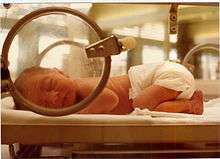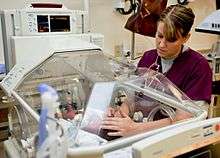Neonatal nursing

Neonatal nursing is a subspecialty of nursing care for newborn infants up to 28 days after birth. The term neonatal comes from neo, "new", and natal, "pertaining to birth or origin". Neonatal nursing requires a high degree of skill, dedication and emotional strength as the nurses care for newborn infants with a range of problems, varying between prematurity, birth defects, infection, cardiac malformations and surgical problems. Neonatal nurses are a vital part of the neonatal care team and are required to know basic newborn resuscitation, be able to control the newborn's temperature and know how to initiate cardiopulmonary and pulse oximetry monitoring.[1]
Levels
There are four different levels of neonatal nursery where a neonatal nurse might work.[2] The updated classification of neonatal levels by the American Academy of Pediatrics (AAP) includes a Level IV.
- Level I consists of caring for healthy newborns. Level I nurseries are now uncommon in the United States. Healthy babies typically share a room with their mother, and both patients are usually discharged from the hospital quickly.[3]
- Level II provides intermediate or special care for premature or ill newborns. At this level, infants may need special therapy provided by nursing staff, or may simply need more time before being discharged.
- Level III, the Neonatal intensive-care unit (NICU), treats newborns who cannot be treated in the other levels and are in need of high technology to survive, such as breathing and feeding tubes. Nurses comprise over 90 percent of the NICU staff.[4]
- Level IV includes all the skills of the level III but involves the extensive care the most critically and complex newborns. This facility will have 24-hour resident neonatologists and surgeons. They are involved with intricate surgical repairs like congenital cardiac issues and acquired malformations.[5]
Changes in neonatal care
Neonatal care became a specialty in the United States in 1960 and that is the same year that the first NICU was established in the United States. There have been some major changes in the Neonatal Care over the past 120 years. Some of these changes include the invention of the incubator, changes in respiratory care, and the development of surfactants.
The incubator
- In 1880, Dr. Tarnier was convinced that the maintenance of internal temperature was key to the premature infant's survival. This led him to introduce the first human incubator. He saw an incubator in use for hatching chickens by a zookeeper, and asked the zoo keeper to design a similar incubator for premature infants.
- Dr. Delee expanded the use and function of the incubator by incorporating an oxygen chamber and an electric controlled thermostat which allowed the incubator to be transported in ambulances.
Respiratory care
- The survival rate of neonates has greatly improved since the discovery of oxygen use in preterm infants.
- Oxygen administration began with a metal forked device in the nostrils, it is now administered through thin plastic tubes in the nostrils
- The first ventilation of an infant was in 1961 in a positive pressure situation, and mechanical ventilation was improved in 1971.
- CPAP masks were first used in 1973 as an alternate less invasive form of support.
Surfactants
- In 1980, the first study of the use of surfactants on infants took place in Japan.
- Surfactant therapy since has improved the infant morality rate by 50%.
- Surfactants combined with the least invasive respiratory therapy (bubble CPAP or nasal CPAP) has greatly improved the infant mortality rate in the US.
Qualifications and requirements
United States
Healthcare institutions have varying entry-level requirements for neonatal nurses. Neonatal nurses are Registered Nurses (RNs), and therefore must have an Associate of Science in Nursing (ASN) or Bachelor of Science in Nursing (BSN) degree. Some countries or institutions may also require a midwifery qualification.[6] Some institutions may accept newly graduated RNs who have passed the NCLEX exam; others may require additional experience working in adult-health or medical/surgical nursing.[2]
Some countries offer postgraduate degrees in neonatal nursing, such as the Master of Science in Nursing (MSN) and various doctorates. A nurse practitioner may be required to hold a postgraduate degree.[6] The National Association of Neonatal Nurses recommends two years' experience working in a NICU before taking graduate classes.[2]
As with any registered nurse, local licensing or certifying bodies as well as employers may set requirements for continuing education.[2]
There are no mandated requirements to becoming an RN in a NICU, although neonatal nurses must complete the Neonatal Resuscitation Program. Some units prefer new graduates who do not have experience in other units, so they may be trained in the specialty exclusively, while others prefer nurses with more experience.
Intensive care nurses receive intensive didactic and clinical orientation, in addition to their general nursing knowledge, to provide highly specialized care for critical patients. Their competencies include the administration of high-risk medications, management of high-acuity patients requiring ventilator support, surgical care, resuscitation, advanced interventions such as extracorporeal membrane oxygenation or hypothermia therapy for neonatal encephalopathy procedures, as well as chronic-care management or lower acuity cares associated with premature infants such as feeding intolerance, phototherapy, or administering antibiotics. NICU RNs undergo annual skills tests and are subject to additional training to maintain contemporary practice.
Europe
Becoming a neonatal nurse isn't a simple task, as it requires a great deal of hard work and an interest in biology in order to be successful. All Neonatal nurses are registered nurses or midwives with The Nursing and Midwifery Council (NWC).
The first step to qualify is to complete a nursing degree. To gain entry into a nursing degree, it is required to have at least GCSE (A-C) in English, Mathematics and a science-based subject, and two to three A-levels with one being in a biological science.[7]
United Kingdom
To be a successful neonatal nurse, it is recommended to have studied mathematics and science-based subjects in high school, such as Calculus, Chemistry, Algebra and Biology. Undergraduate college studies should consist of two years of foreign language, Mathematics and Science should be covered in three years, and after four years, there should be competency in English.
The minimum requirement for a Neonatal nurse is to complete an associate degree in Applied Science. The time frame will last up to 2 years and can be completed at a community college or a junior college. Gaining an associate degree is sufficient, however a bachelor's degree will provide a wider range of career opportunities.
A BSc in nursing degree curriculum or a BSN usually takes up to four years, and there is opportunity for a higher salary. This training program involves learning how to distribute vaccinations, and how to give the necessary and the basic care of patients.
The coursework will be joined with the clinical experience to assist students in exploring several healthcare settings. Becoming qualified as a neonatal nurse involves the four-year Bachelor of Science in Nursing degree. To advance in a future career, it is best to aim to maintain an above 3.0 average grade in college.
Students must pass the NCLEX (National Council Licensure Examination) exam that is usually provided prior to earning their license. This allows them to be registered with the right of practice.
When progressing further in continuing to practice as a neonatal nurse with the associate degree or bachelor's degree, it is advised to keep learning and continuing education. In order to become a Neonatal Nurse Practitioner, it is required to continue studying by completing a Master of Science in Nursing degree.[8]
Australia
In Australia, to work as a neonatal nurse you will need to be a Registered Nurse (RN) or Midwife firstly.
You will need two years of nursing experience and will need to gain practical experience and employment in the neonatal unit before being eligible to undertake postgraduate studies in neonatal nursing. This usually requires undertaking a Graduate Diploma Degree in Clinical Nursing.[9]

Roles and responsibilities
Duties of a neonatal nurse usually include supplying vital nutrients to newborns, changing feeding tubes, administering medication, observing vital signs, performing intubations and using monitoring devices. In the common situation where premature and sick newborns' lungs are not fully developed, they must be certain infants are breathing and maturing properly. Neonatal nurses work together with upper-level nurses and physicians and facilitate treatment plans and examinations. They have regular interaction with patients' families, therefore are required to educate parents or relative on the infant's condition and prepare care instructions after the infant is discharged from the hospital. If parents have questions which neonatal nurses are incapable of answering, they may direct them to another medical staff member who is able to.[10][11]
APGAR scoring
All nurses working in a birthing centre have an important role in assessing the newborn immediately after birth. The assessment of the neonate's appearance (colour), pulse (heart rate), grimace (in response to unpleasant stimuli such as bulb suctioning the pharynx), activity (muscle tone and/or movement), and respiratory effort via the APGAR scoring system is essential to guide the baby's care (see Understanding the APGAR scoring system). The nurse is often directly responsible for assigning the APGAR scores at 1 and 5 minutes of life. Each of the five assessment areas is given a score of 0, 1, or 2. The maximum score possible is 10. Scores of 7 or above are considered normal for full-term newborns. If the total score is below 7, or any area is scored 0 at 5 minutes of life, resuscitation efforts and scoring should continue every 5 minutes until 20 minutes of life.
Beyond assessing the five components that make up the APGAR score, it's essential to understand its meaning. The APGAR score assigned at 1 minute of life reflects how the fetus tolerated the in utero environment and/or the labor and delivery process. All subsequent APGAR scores reflect the newborn's response to interventions during the transition from intrauterine to extrauterine life. These nursing interventions include keeping the baby warm, stimulating the baby to breathe, giving breaths to the baby who isn't breathing well, and performing chest compressions if needed.[1]
References
- 1 2 Pieron, Petri. "Nursing made incredibly easy!". Neonatal nursing care 101. Lippincott Williams and Wilkins. 10 (5). doi:10.1097/01.NME.0000418034.61512.67.
- 1 2 3 4 "Neonatal Nurse". Nurses for a Healthier Tomorrow. Nurses for a Healthier Tomorrow. Retrieved October 26, 2010.
- ↑ Selga, Anna May A. "Hospital Length of Stay and Readmission Rates for Normal Deliveries: a controlled evaluation". Ilocos Training and Regional Medical Center. Manila: Department of Health, Republic of the Philippines. Archived from the original on April 23, 2007. Retrieved October 26, 2010.
- ↑ Whitfield, Jonathan M.; Peters, Beverly A.; Shoemaker, Craig (July 2004). "Conference summary: a celebration of a century of neonatal care". Proceedings. Dallas: Baylor University Medical Center. 17 (3): 255–258. PMC 1200660
 . PMID 16200108.
. PMID 16200108. - ↑ "Levels of Neonatal Care". Committee on Fetus and Newborn. American Academy of Pediatrics. 2012. Retrieved June 5, 2013.
- 1 2 "Frequently Asked Questions". Global Unity for Neonatal Nurses. Boston: Council of International Neonatal Nurses. 2009. Retrieved October 26, 2010.
- ↑ "Neonatal Nurse". Plotr. Retrieved 16 May 2016.
- ↑ "Neonatal Nurse Salary". Salary Voice. 2015. Retrieved 16 May 2016.
- ↑ http://www.acnn.org.au/about/neonatal-nursing. Missing or empty
|title=(help) - ↑ "What Are the Duties of a Neonatal Nurse?". learn.org. Retrieved 2016-05-17.
- ↑ "NICU RN: Job Description, Requirements and Duties". Study.com. Retrieved 2016-05-17.
- Harper, Douglas. "neonatal". Online Etymology Dictionary. Douglas Harper. Retrieved October 26, 2010.
External links
- Association of Women's Health, Obstetric and Neonatal Nurses
- The Academy of Neonatal Nursing
- Pre Conception& Neonatal